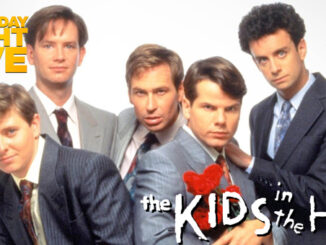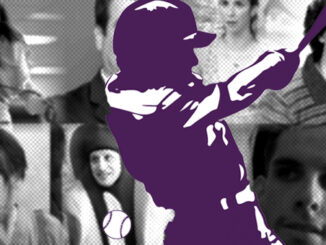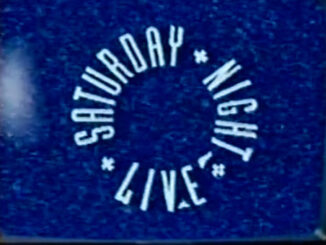
The spring of 1980 was a time of uncertainty at Saturday Night Live. The fame and success that the show was experiencing, was also taking its toll. Powerhouse combo John Belushi and Dan Aykroyd had already left the show at the end of the previous season to concentrate on films. Hollywood was beckoning their fellow cast mates to follow and some were making noises that they were ready to go. To shore up the on-screen talent, executive producer Lorne Michaels started rotating a number of the show’s writers in and out of episodes as “Featured Players,” though it would still be a few years before the audience would be quite comfortable with the idea of rotating cast members.
And as SNL‘s fifth season continued on with it looking more likely that some if not all of the remaining original cast members were going to head out the door, ABC smelled blood in the water and decided to launch their own late-night comedy sketch series and steal NBC’s audience for themselves. Turning to producers Bill Lee and John Moffitt, the network tasked them to create their own sketch series. Scouring the Los Angeles comedy scene, they assembled a cast of nine comics – Mark Blankfield, Maryedith Burrell, Melanie Chartoff, Larry David, Darrow Igus, Brandis Kemp, Bruce Mahler, Michael Richards and John Roarke. And on April 11, 1980, in the waning weeks of the Saturday Night Live‘s fifth season, Fridays premiered with the first of its twelve-episode first season run.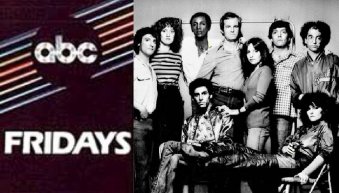
It was inevitable right from the start Fridays would be compared to Saturday Night Live. And that is both a fair and unfair comparison. SNL had a head start when it premiered in that a majority of its cast and writers had worked in various combinations with each other at Toronto and Chicago’s Second City theaters or at the National Lampoon. The Fridays cast were culled from various comedy clubs and aside from cast members Brandis Kemp and Mark Blankfeld, who were married at the time, had not really worked together before. Many, like Richards, had virtually no experience in front of a camera. As such, the show’s first season was rough around the edges and critics were quick to point that out.
Fridays also had a musical guest each episode. While the show would occasionally book currently popular acts like The Beach Boys, Stevie Wonder and Kenny Loggins, they were far more likely to embrace the New Wave and punk movements, bringing on acts like Devo, the Cars, the Plasmatics and Split Enz. The bands AC/DC, The Clash and Stray Cats all made their US television debuts on the show. Although Long Island born and bred, the Stray Cats only had a record deal in Great Britain, but not in the US. As they performed, a crawl ran at the bottom of the screen inviting record labels to sign them.
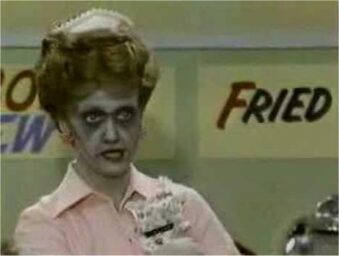 But Fridays was always much more than just an attempt to replicate the Saturday Night Live formula, even if the inclusion of “The Friday Edition” would superficially suggest otherwise. The show came out of the box with an energy and attitude that belied the laid-back California stereotype of where it was originating. It also stood in a stark contrast to how, in its just concluded fifth year, Saturday Night Live has maybe lost some of its own edge. That doesn’t mean that they didn’t go over the line a few times in their attempt to find where that line was. In its third episode the gore that accompanied the sketch “Diner of the Living Dead,” and the grossness of the talk show parody “Women Who Spit” set critics grumbling and led to some ABC affiliates to drop the show.
But Fridays was always much more than just an attempt to replicate the Saturday Night Live formula, even if the inclusion of “The Friday Edition” would superficially suggest otherwise. The show came out of the box with an energy and attitude that belied the laid-back California stereotype of where it was originating. It also stood in a stark contrast to how, in its just concluded fifth year, Saturday Night Live has maybe lost some of its own edge. That doesn’t mean that they didn’t go over the line a few times in their attempt to find where that line was. In its third episode the gore that accompanied the sketch “Diner of the Living Dead,” and the grossness of the talk show parody “Women Who Spit” set critics grumbling and led to some ABC affiliates to drop the show.
But that abbreviated first season helped the cast and writers get to know each others’ strengths, and it shows in the subsequent second and third season. In the fall of 1980, as the new incoming cast of SNL’s sixth season was getting pelted with a barrage of “Saturday Night Dead” reviews from critics, Fridays was humming on all cylinders having settled into its own format and style.
Each week would open with an ambitious large-scale sketch, which often would often span across more than one set, use films or television shows as a starting point and would contain some of the show’s more pointed political satire. Some of these sketches include “The Moral Majority Comedy-Variety Hour,” a variety show produced by the self-appointed guardians of purity, the Moral Majority, featuring “The Not Too Righteous For Prime Time Players,” “A Night In Tehran,” in which the Marx Brothers find themselves in the ongoing Iranian revolution, “The Road To El Salvador,” a parody of the old Bob Hop-Bing Crosby Road pictures which finds the duo caught up in the US’s dealings with that South American country and “Altered Statesman,” in which Ronald Reagan (John Roarke) accidentally transforms himself into Richard Nixon when using a sensory deprivation tank and psychedelic mushrooms to try and find a way to bring America back to its imagined glory days.
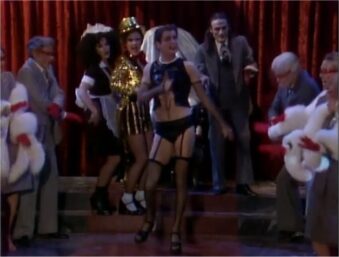 Things got even more pointed as Reagan prepared to enter the White House. The month the before Reagan’s inauguration, the show presented the sketch “The Ronny Horror Picture Show.” A savage and savagely funny attack on the incoming administration, it set many of the Reagan administration principals into Rocky Horror Picture Show characters with Roarke’s Reagan impression being squeezed into the fishnets and corset of Tim Curry’s Dr. Frank N. Furter. (“I’m just an arch conservative, anti-intellectual, chief executive… From California!”) The result was a nearly twenty minute long extravaganza attacking the changing tide of the country’s political mood, complete with musical numbers, that had the studio audience on its feet by its end. It was crazy ambitious even by the standards of the usual opening sketches presented by the show. One person, however, was not particularly amused. Rocky Horror Picture Show producer Lou Adler reportedly felt that the parody hewed too close to the original film and one angry phone call to ABC later, the piece was suddenly barred from being repeated. (That ban, if it ever did exist, has apparently since been lifted.)
Things got even more pointed as Reagan prepared to enter the White House. The month the before Reagan’s inauguration, the show presented the sketch “The Ronny Horror Picture Show.” A savage and savagely funny attack on the incoming administration, it set many of the Reagan administration principals into Rocky Horror Picture Show characters with Roarke’s Reagan impression being squeezed into the fishnets and corset of Tim Curry’s Dr. Frank N. Furter. (“I’m just an arch conservative, anti-intellectual, chief executive… From California!”) The result was a nearly twenty minute long extravaganza attacking the changing tide of the country’s political mood, complete with musical numbers, that had the studio audience on its feet by its end. It was crazy ambitious even by the standards of the usual opening sketches presented by the show. One person, however, was not particularly amused. Rocky Horror Picture Show producer Lou Adler reportedly felt that the parody hewed too close to the original film and one angry phone call to ABC later, the piece was suddenly barred from being repeated. (That ban, if it ever did exist, has apparently since been lifted.)
The show also developed its own set of recurring characters including Richards’ Battle Boy, Mahler’s Latin DJ, David’s “Solly Mullins: Temp Worker,” Blankenfield’s totally tweaked-out pharmacist and Ken the Hunchback, Mahler and David’s rabbis Feinberg and Himmelman and Nat E. Dread, Igus’s Rastafarian who really, really likes the ganja.
And then there was the Andy Kaufman incident, probably the thing for which Fridays is best remembered. Kaufman was a comic who turned comedy into absurdist performance art, and whose fame (or notoriety, you choose) had grown in no small part to his appearances in the first few seasons of Saturday Night Live. Once Fridays started up, it was perhaps inevitable that he would get booked for the show as well. And for that first appearance late in the show’s second season, Andy and his writing partner/cohort in high jinks Bob Zmuda decided that they wanted to have some fun with the show’s live broadcast format, by showing that “anything can happen.”
The show starts off with a cold open featuring Kaufman apparently in mid-monologue, laughing hysterically. “I can do anything I want to up here and they can’t do a thing to me,” states Kaufman mischievously pointing out how they are broadcasting live. “They told me I couldn’t say the word ‘crap,’ but there I said it.” Kaufman taunts the producers a little more before the show’s opening title sequence starts.
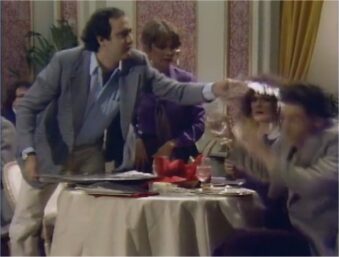 But things really come to a head in a sketch towards the end of the show. The audience at home saw a simple restaurant scene in which two couples (Kaufman, Chartoff, Richards and Burrell) were enjoying an evening out. At various intervals, each character would slip off to the bathroom to ostensibly smoke a joint before returning, with the hook of the sketch being that no one at the table was aware that everyone else had also brought some pot with them. But as the sketch continued, Kaufman starts to balk at the content, muttering that he can’t “play stoned.” His scene partners try to egg him along and then finally Richards appears to lose his cool and grabs the cue cards from a stage hand and throws them at Kaufman. Kaufman responds by pouring a glass of water on Richards’s head. As chaos starts to break out on the stage, producer Jack Burns steps in and gets into a shoving match match with Kaufman. Before we can see the chaos escalate any further, the show cuts to commercial. The following week featured a pre-recorded apology from Kaufman to the viewing audience.
But things really come to a head in a sketch towards the end of the show. The audience at home saw a simple restaurant scene in which two couples (Kaufman, Chartoff, Richards and Burrell) were enjoying an evening out. At various intervals, each character would slip off to the bathroom to ostensibly smoke a joint before returning, with the hook of the sketch being that no one at the table was aware that everyone else had also brought some pot with them. But as the sketch continued, Kaufman starts to balk at the content, muttering that he can’t “play stoned.” His scene partners try to egg him along and then finally Richards appears to lose his cool and grabs the cue cards from a stage hand and throws them at Kaufman. Kaufman responds by pouring a glass of water on Richards’s head. As chaos starts to break out on the stage, producer Jack Burns steps in and gets into a shoving match match with Kaufman. Before we can see the chaos escalate any further, the show cuts to commercial. The following week featured a pre-recorded apology from Kaufman to the viewing audience.
The thing was, the fracas was entirely staged. The only people who knew that Kaufman was going to break character in the sketch were Burns and the three other actors in the scene. None of the rest of the cast and none of the crew knew what was about to happen, and Andy only told Chartoff, Richards and Burrell to expect something. He didn’t elaborate on when he would start to deviate from the written sketch.
Was it funny? Maybe more in concept than in execution. The studio audience, a usually raucous crowd to begin with, whooped it up in the moment. And while it certainly tickled Kaufman’s prankster sense of humor, it did serve to highlight the danger that can exist in live television, but seldom did.
(A Saturday Night Live-related post script – The evening after the staged sketch breakdown on Fridays, SNL had its own unplanned moment, when Charles Rocket said “Fuck” during the show’s good nights segment. You can read more about that here.)
Despite good ratings in its 11:30 time slot, in January 1982 ABC bumped Fridays to a midnight start time when it expanded its late night news magazine show Nightline from four to five nights. (Which technically made it airing on Saturday on the East Coast although still being broadcast live on its titular night on the West Coast.) Dry newsman Sam Donaldson made for a poor lead-in to the raucous comedy and ratings began slipping almost immediately. In a last ditch attempt to get people to watch, they moved the last show of the third season to air at 10:00 pm. But that it put it against CBS’s ratings juggernaut Dallas and even though it was a rerun of the popular primetime soap, Fridays didn’t stand a chance. ABC swung the cancellation ax, ending the series after 58 episodes.
When Fridays ended, Saturday Night Live producer Dick Ebersol, who was called out live for being in a Fridays audience in one episode, reportedly extended an invitation to the cast and writers to join his show over on the East Coast. Only Larry David would eventually take him up on the offer. The rest headed off on their own directions. Show co-creator John Moffitt took some of the writing staff and cast member Rich Hall, who joined the show during its second season, and formed HBO’s news satire series Not Necessarily The News, which would run from 1983 to 1990. Hall would later move on to SNL as a writer-cast member for its tenth season. Larry David, after his stop at Saturday Night Live in season 10, would go on to recruit Fridays writer Larry Charles and Michael Richards for a little sitcom he was creating with stand-up Jerry Seinfeld for NBC.
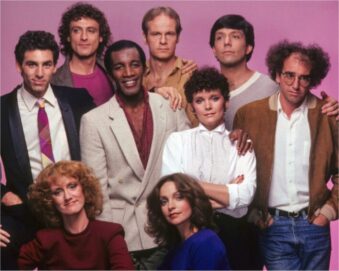 Now over four decades later, Fridays is not much remembered except by comedy fans. A “Best of” DVD box set features a handful of shows, but not full seasons from across the show’s run, was released in 2013. Edited versions of the show ran on the USA Network for about a year in the late 1980s. Reportedly, and reports have differed, either Richards or David has been instrumental in keeping the show out of circulation as much as it has been.
Now over four decades later, Fridays is not much remembered except by comedy fans. A “Best of” DVD box set features a handful of shows, but not full seasons from across the show’s run, was released in 2013. Edited versions of the show ran on the USA Network for about a year in the late 1980s. Reportedly, and reports have differed, either Richards or David has been instrumental in keeping the show out of circulation as much as it has been.
But the show has not been completely memory-holed and has even started to resurface in the streaming age. A quartet of episodes from the show’s first season are available on Amazon Prime Video and nearly half the series’ episodes are available on the Tubi streaming service where hopefully, it will lead to the show gaining a new generation of fans.


